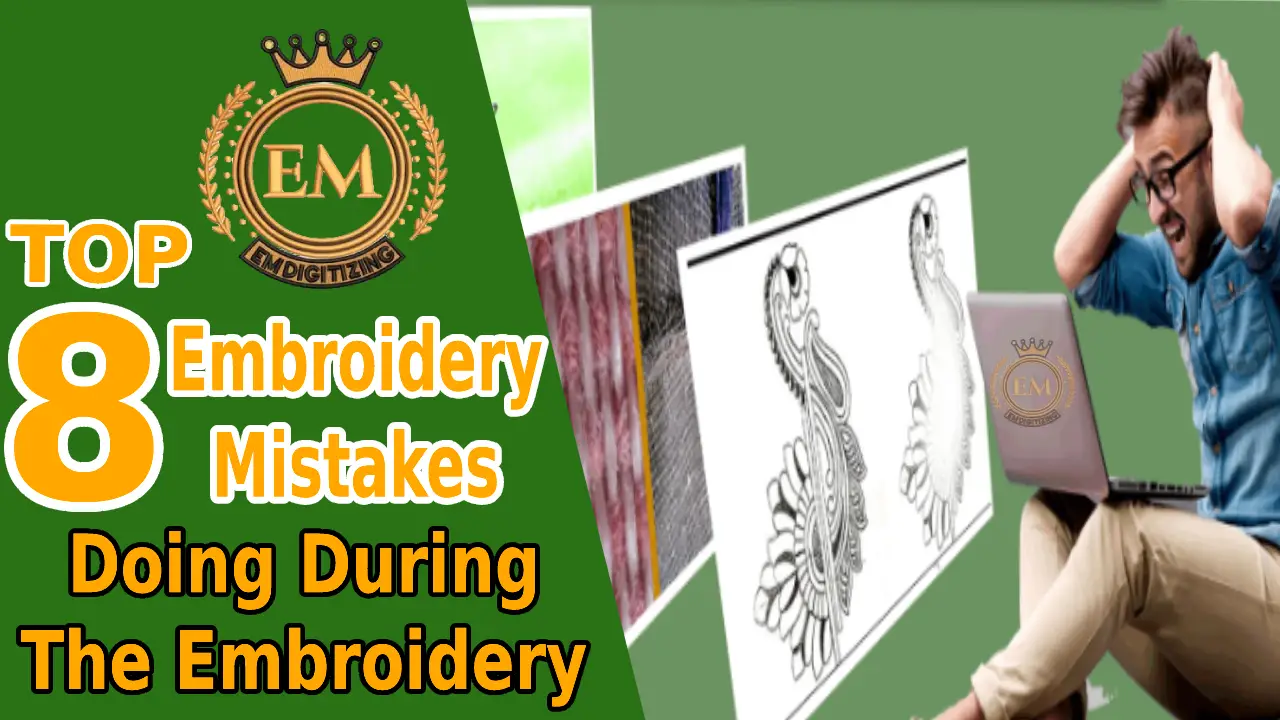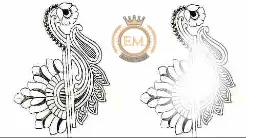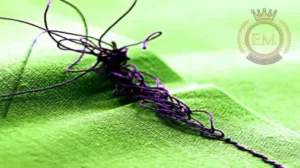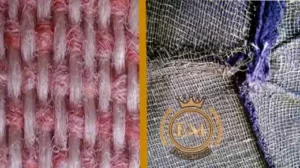Dans cet article, nous vous informerons des principales erreurs de broderie qu'ils commettent en brodant. Cela vous arrivera certainement à un moment donné si vous travaillez sur un système de broderie à la maison ou dans un magasin professionnel et que le motif est mal cousu et doit être modifié..

Services de numérisation de broderie
When you’;j'ai dépensé 10 années de travail avec un Machine à broder, you’;je vais sûrement faire quelques erreurs de broderie. C'est certainement vrai pour moi. Le plus drôle c'est, plus je partage d'histoires avec d'autres geeks de la broderie machine, plus j'entends les mêmes histoires encore et encore. Oui, Je sais, les erreurs de broderie sont une partie inévitable du processus d'apprentissage. But if you’;re just starting out –; wouldn’;Il est utile de savoir quels sont certains d'entre eux afin de pouvoir en réduire certains.?
Alors voilà – mon top 10 erreurs de broderie et comment les éviter. J'espère que cela vous aidera à apprendre, ou au moins confirme que tu n'es pas seul. We’;j'ai tous fait une de ces bêtises.
1. S'éloigner de votre machine à broder
Ne vous éloignez pas de la machine pendant qu'elle coud un motif. A hard lesson I’;J'ai appris, c'est qu'au moment où je m'éloigne de mon Machine à broder C'est le moment où l'enfer se déchaîne. Lors de mon premier cours de broderie, I actually asked my embroidery instructor if it was okay for me to walk away from it while machine stitching and she said… “;Bien sûr, if you want.”;
Cependant, c'était un conseil terrible après m'être éloigné plusieurs fois de ma machine alors qu'elle fonctionnait et que quelque chose de catastrophique s'est produit. I would like to revise that answer to a firm “;no”;. S'éloigner de votre machine à broder n'est pas une bonne idée.
Arrêtez le Machine à broder lorsque vous êtes proche et que vous pouvez entendre ou voir que quelque chose ne va pas. J'ai sauvegardé de nombreux projets lorsque la machine était bloquée parce que j'ai exécuté et arrêté la machine, résolu le problème, et je l'ai redémarré. Effectuez plusieurs tâches si vous le devez (fer, fil, organisez votre tiroir d’imagination…) Faites ce qu'il faut pour éviter de vous endormir devant la machine, but don’;ne me laisse pas emporter.
2. Sélection d'une méthode de transfert inappropriée
 Il existe de nombreuses façons de transférer votre conception de broderie du papier au tissu. Vous pouvez utiliser des stylos facilement lavables ou solubles dans l'eau sur votre matériel. S'ils ne sont pas accessibles, utiliser un crayon. Évitez les marqueurs permanents et les crayons. Dans certains cas, it won’;Peu importe la longueur des lignes de transfert, car votre point couvrira toutes les lignes. Voici les nouvelles erreurs de broderie. If your design lines aren’;pas complètement couvert, choose a transfer method that can be removed when you’;re fait. Des crayons à craie en céramique et des crayons de couleur solubles dans l'eau peuvent être utilisés.
Il existe de nombreuses façons de transférer votre conception de broderie du papier au tissu. Vous pouvez utiliser des stylos facilement lavables ou solubles dans l'eau sur votre matériel. S'ils ne sont pas accessibles, utiliser un crayon. Évitez les marqueurs permanents et les crayons. Dans certains cas, it won’;Peu importe la longueur des lignes de transfert, car votre point couvrira toutes les lignes. Voici les nouvelles erreurs de broderie. If your design lines aren’;pas complètement couvert, choose a transfer method that can be removed when you’;re fait. Des crayons à craie en céramique et des crayons de couleur solubles dans l'eau peuvent être utilisés.
3. Essayer de tout encercler
Le premier projet que j'ai tenté sur ma machine à broder consistait à monogrammer des serviettes.. Je ne sais pas mieux, J'ai essayé de plier les serviettes. j'ai dû essayer 100 fois pour aligner correctement la serviette dans le cerceau et ne pas la laisser sortir. C'était dur, but I assumed I’;je m'améliorerais avec le temps.
Quand ma sœur plus expérimentée a vu ce que je faisais, she laughed at me –; choqué d'avoir essayé de jeter l'éponge. Mais quel autre choix avais-je???
C'est à ce moment-là que j'ai appris à nager avec des serviettes (et à peu près tout le reste) dans le cerceau. Au lieu de coller la serviette dessus, tu agrafes le stabilisateur. Vous pouvez utiliser un adhésif en spray temporaire ou un stabilisateur adhésif pour faire adhérer la serviette au stabilisateur.. Si simple et rapide.
4. Utilisé de mauvaises choses au lieu de stabilisateurs
La seule fois où vous brodez sans entoilage: Jamais. Un stabilisateur est nécessaire pour maintenir votre vêtement/tissu/serviette, etc. en place pendant que vous brodez..
Il existe de nombreux types de stabilisateurs, mais les deux types principaux sont coupés et déchirés. Généralement, “;si tu le portes, don’;t tear it.”; Le stabilisateur Cut-A doit être utilisé sur le dos de tout ce qui est porté., surtout s'il est extensible, c'est à dire des sweat-shirts, t-shirts, etc. Le déchirement est préférable pour les projets lourds comme la broderie sur des serviettes. En savoir plus sur les stabilisateurs pour la broderie machine.
UN stabilisant soluble dans l'eau est un stabilisant qui se dissout au contact de l’eau. Il est utilisé pour de nombreux projets de cerceaux intérieurs, confection de patchs et de lacets autoportants. En plus d'utiliser le bon type de stabilisateur, il est également important de s'assurer que le stabilisateur est bien enveloppé. Il doit être plat et bien tiré., suffisamment serré pour qu'une pièce de monnaie puisse rebondir dessus.
5. Mauvais type de fil utilisé
 Le fil à broder a une texture différente et est superbe une fois cousu.. Il existe de nombreuses variétés de fil à broder, et presque tous les passionnés de broderie ont une marque préférée. I would recommend not investing heavily in a brand before determining if your machine “;likes”; la marque. Certaines personnes jurent que certaines marques de fil ont tendance à se casser plus souvent sur une machine particulière.. je, personnellement, ne pas avoir un fort préjugé envers une marque en particulier. En savoir plus sur le fil à broder machine.
Le fil à broder a une texture différente et est superbe une fois cousu.. Il existe de nombreuses variétés de fil à broder, et presque tous les passionnés de broderie ont une marque préférée. I would recommend not investing heavily in a brand before determining if your machine “;likes”; la marque. Certaines personnes jurent que certaines marques de fil ont tendance à se casser plus souvent sur une machine particulière.. je, personnellement, ne pas avoir un fort préjugé envers une marque en particulier. En savoir plus sur le fil à broder machine.
En plus d'utiliser du fil à broder (contrairement au fil ordinaire), il est également très important d'utiliser du fil de canette à broder pour le bobbing. Le fil de la canette à broder est plus fin que le fil normal, ce qui permet de tirer le fil supérieur vers l'arrière du tissu., en s'assurant qu'aucun fil de canette n'est visible sur le dessus. En savoir plus sur le fil de canette de la broderie machine.
6. Les mauvais types de conception d’appliques ont été choisis
Soyez sensible lorsqu'il s'agit de design et en tissu choix. La plupart des motifs de broderie et d'appliqués sont conçus pour des tissus en coton de poids standard avec une densité de points. Lorsque vous essayez de coudre ces motifs sur d'autres types de tissus, vous devrez peut-être faire quelques ajustements, comme l'ajout de couches supplémentaires de stabilisateur. Cependant, the reality is that some designs don’;Je ne couds pas bien sur certains tissus.
7. Ne pas gérer les fichiers
Presque tous les accros à la broderie possèdent une tonne de fichiers de broderie. Mais une fois que tu commences à rassembler un groupe, it’;s easy to forget what’;c'est quoi. Organisez vos fichiers dans des dossiers qui vous conviennent. And then –; sauvegardez-les! Une autre excellente stratégie consiste à conserver toutes les confirmations par courrier électronique des modèles que vous achetez dans un dossier afin de pouvoir revenir au magasin et demander un autre téléchargement si vous perdez le modèle..
8. Choisir le mauvais tissu
 Avant de commencer toute conception de tissu, rappelez-vous le type de broderie que vous avez en tête, puis décidez quel matériau peut vous aider à produire les meilleurs résultats pour ce type de couture.
Avant de commencer toute conception de tissu, rappelez-vous le type de broderie que vous avez en tête, puis décidez quel matériau peut vous aider à produire les meilleurs résultats pour ce type de couture.
Utiliser un tissu à broder avec un faible nombre de fils entraînera de mauvais points, et un tissu effiloché n'est pas non plus une bonne option. Vous pouvez faire des compromis sur la cohérence, et finalement, ces tissus peuvent ne pas refléter l'effort que vous consacrerez à leur couture. Le lin épais ou le bon tissu en coton seront les meilleurs pour les travaux de broderie..
C'est à ce moment-là que l'arrière de votre fil s'emmêle, but you don’;je ne le remarque pas, et tu cous joyeusement. Si vous ne faites pas attention, vous pouvez créer de gros nœuds et des touffes de fil derrière le cadre. Les fils longs semblent souvent emmêlés, ce qui entraîne des rebondissements gênants et vous perdez du temps à essayer de dénouer les nœuds! Si vous débutez, vous devriez vérifier l'arrière de votre cerceau avant et après. It doesn’;ça prend pas beaucoup de temps, et à long terme, cela peut vous faire gagner beaucoup de temps. Cela vous évitera ainsi des erreurs de broderie commises par les nouveaux brodeurs..
Conclusion
N'ayez jamais peur de faire une erreur! Même les professionnels peuvent faire des erreurs. Transformer l’échec en un résultat positif est toujours un état d’esprit. Essayez de transformer et d’interpréter les erreurs comme des leçons d’apprentissage, voire une opportunité de développer de nouvelles stratégies. Voilà donc quelques-unes des erreurs de broderie que commettent la plupart des brodeurs débutants..
Les couches de tissu et de stabilisateur se déplacent, and you’;Je verrai des lacunes dans la couture. Deuxième, cerceau. Pas de cerceau, ou pas assez serré, peut conduire à un écart. J'ai mentionné plus tôt comment les points ajoutent du poids à un morceau de tissu, et comment un stabilisateur aide à soutenir le tissu.
Lorsque les motifs de broderie et les points ne sont pas disposés correctement, c'est vu comme un défaut. Le regroupement se produit lorsque les coins d'un motif de broderie ne sont pas nets en raison d'une accumulation de fils à un moment donné.. Ce défaut peut être constaté lorsque la broderie est trop dense ou épaisse à certains endroits.
Les ruptures de fil et les conflits peuvent ou non être des problèmes distincts. La casse du fil peut être causée par des problèmes de tension, synchronisation des machines, interférence sur le chemin du thread, fil coincé sous la bobine, fil vieux ou déchiré, ou une mauvaise numérisation. Les fils de discussion gelés ont généralement plus à voir avec le timing, bavures, et des pseudos dans le chemin du fil.
Proper thread tension will help prevent bird’;Nids et points de canette visibles, assurant un produit de meilleure qualité et une couture plus fluide. Bill Garvin, le propriétaire de l'entreprise de réparation de machines à broder BG Tech Services, explique l'importance d'une bonne tension de fil et comment régler la tension de votre machine.
